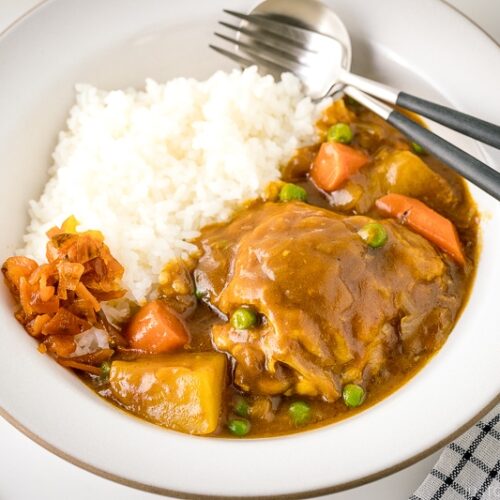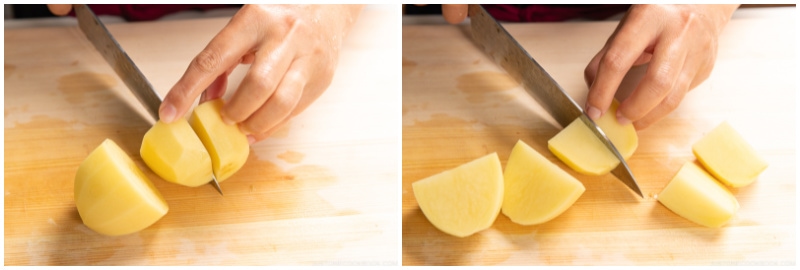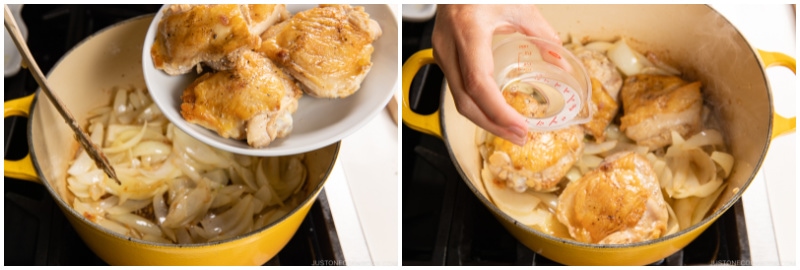Rich, aromatic, and packed with complex flavors, this Japanese Bone-In Chicken Curry is delicious right out of the gate! It’s extra comforting to serve it Japanese style over steamed rice. Since the spices are on the milder side, this curry is a favorite even among children.

Japanese curry or Kare (カレー) is one of the nation’s most popular comfort foods. To satisfy the frequent cravings, we have a decent array of curry menus – from Curry Udon and Curry Doria, to Curry Bread and Katsu Curry – all delicious in their own right.
Today’s recipe is Bone-In Chicken Curry (骨付きチキンカレー). It takes slightly longer to cook because of the bone-in meat, but you get super tender chicken and mega flavorful thick curry sauce that reign supreme.

How to Cook Bone-In Chicken Curry
Ingredients You’ll Need
You will only need simple pantry ingredients to make this dish.
- Bone-in, skin-on, chicken thighs (for the best flavor!)
- Onions
- Carrots
- Yukon gold potato (You can also use Russet potato, but it dissolves more easily)
- Green peas
- Garlic
- Chicken stock (You can use less-sodium one, and add salt if necessary)
- Sake
- Japanese curry roux (store-bought or homemade)
- Soy sauce
- Mirin

5 Easy Cooking Steps
- Cut ingredients and season the chicken with salt and pepper.
- Brown the chicken first, then take it out, and saute the onion till tender.
- Add the chicken back along with sake and stock, and let it simmer for 45 minutes.
- Add the carrot and potato and cook for another 15 minutes.
- Add curry roux, seasonings, and green peas. Serve and enjoy!

Helpful Cooking Tips
- Prick the chicken skin with a knife/fork – This technique will cook the chicken from the inside out keeping it moist and flavorsome, while the fat oozes out to crisp up the skin.
- Cut the onion into wedges for texture – I love sweet, tender, caramelized onion in the curry. I cut the onion into thick wedges, which add some texture to the curry.
- Cut the carrot and potato in similar size – Cut these two veggies into bite-size, small pieces, as we will only cook for 15 minutes. We do not want to overcook them.
- Brown the skin side first until the skin releases itself – Chicken skin releases fat which equals to flavors. The skin will first stick to the pan, but once it’s crisp up, you can easily flip the chicken.
- Saute the onion till tender and caramelized – For extra flavor boost!
- Turn off the heat while you dissolve curry roux – Once curry is in, keep the heat at the lowest. Curry will burn too easily.
- Use two different brands of curry roux (sometimes mix the spice level, like mild and medium spicy) – Store-bought curry doesn’t have to be boring! Mix it up so it’s not always same old flavor.
- Adjust the consistency of the curry – You can always adjust the thickness of the curry with stock/water. If your chicken stock is salty, use water.
- Add soy sauce and mirin – Why? Read the next section.

Personalize Store-bought Curry with Additional Seasonings
Many home cooks in Japan add some kind of condiments/seasonings to give additional layers of flavors to the store-bought curry. Today I added mirin for mild sweetness and soy sauce for umami, but you can add different seasonings. Here are the common add-ons.
- Butter
- Chocolate
- Coffee
- Grated apple
- Honey
- Ketchup
- Mirin
- Oyster sauce
- Red wine
- Sake
- Soy sauce
- Tonkatsu sauce
- Worcestershire Sauce
- Yogurt
Have you tried any of the flavor add-ons? If so, what are some of your favorites?

What to Serve with Bone-In Chicken Curry
Typically, Japanese curry is served with steamed rice, along with Pickled Rakkyo (Shallots) and Fukujinzuke and a bowl of salad.

- Fukujinzuke (福神漬) – It is lightly brined in a sweet soy sauce and does not undergo fermentation. The crunchy condiment is more like a chunky chutney, served with Japanese curry. It features seven vegetables as the name inspired by the Seven Lucky Gods (七福神).
- Rakkyo (ラッキョウ) – A pickle of the bulb of Chinese onions/shallots, Rakkyo can be pickled in salt, soy sauce, or sweet vinegar. It resembles a garlic clove but with a taste similar to shallots.

Check out our various salad recipes and salad dressings on the blog!
Other Curry Recipes You May Enjoy

- Chicken Curry
- Beef Curry
- Pressure Cooker Seafood Curry
- Pressure Cooker Japanese Curry
- Sapporo Soup Curry

Wish to learn more about Japanese cooking? Sign up for our free newsletter to receive cooking tips & recipe updates! And stay in touch with me on Facebook, Pinterest, YouTube, and Instagram.

Bone-In Chicken Curry
Video
Ingredients
- 4 bone-in skin-on chicken thighs (1.8 lb, 800 g)
- ½ tsp Diamond Crystal kosher salt
- freshly ground black pepper
- 2 onions (1 lb, 454 g)
- 1 Yukon gold potato (6.5 oz, 184 g)
- 2 carrots (4 oz, 113 g)
- 3 cloves garlic (minced or crushed)
- ¼ cup green peas (1.3 oz, 36 g)
- 2 Tbsp neutral oil (for cooking)
For the Curry Sauce
- ¼ cup sake
- 2 cups chicken stock/broth (or use vegetable stock)
- ½ cup water (add more if needed)
- ½ package Japanese curry roux (3.5–4.2 oz, 100–120 g; or make my homemade curry roux; I use 2 different brands and mix)
- 1 Tbsp mirin
- 1 Tbsp soy sauce
Instructions
- Gather all the ingredients.

To Prepare the Ingredients
- Prick skin of 4 bone-in skin-on chicken thighs with the tip of your knife (so the flavors will penetrate the skin). Cut off the excess fat with a pair of scissors (or knife).

- Season the chicken with ½ tsp Diamond Crystal kosher salt and freshly ground black pepper on both sides.

- Cut 2 onions into wedges. The wedge cut adds more texture; however, you can also thinly slice or dice.

- Peel and cut 1 Yukon gold potato into 8 pieces.

- Peel and cut 2 carrots into bite-size pieces. Here, I use the Japanese rangiri cutting technique. Set aside the vegetables on a tray or plate.

To Cook the Curry
- In a large pot (I use a Dutch oven), heat 1 Tbsp neutral oil on medium-high heat. When it’s hot, sear the chicken on the skin side first. Do not crowd the pan to avoid steaming the chicken and cook in batches if necessary.

- Flip the chicken and cook the other side for 2 minutes and then transfer to a plate until the rest is done.

- Add the onion to the pot and coat with the oil using a wooden spoon/spatula. If there is not enough oil, add ½–1 Tbsp more oil.

- Add the minced/crushed 3 cloves garlic and sauté, stirring occasionally, until the onions are tender. If the burnt spots on the bottom of the pot need some scraping, you can add sake here (instead of the next step) to loosen them up.

- Add the chicken back into the pot and add ¼ cup sake.

- Add 2 cups chicken stock/broth and ½ cup water, just enough to almost cover the chicken. If you use a larger pot, it may not cover, so please adjust the amount of stock/water. This is not a soupy curry, so we do not need much liquid.

- Cover the lid and bring it to a simmer. When simmering, skim the scum and foam with a fine-mesh skimmer.

- Cook covered on low heat for 45 minutes.

- Add the carrots and potatoes and make sure they are submerged in the cooking liquid.

- Cook covered until they are tender, about 15 minutes.

- Turn off the heat and dissolve ½ package Japanese curry roux, one cube at a time in a ladleful of hot broth. When the first cube is dissolved, release it to the broth and mix gently without breaking the tender vegetables. Repeat the process until you finish dissolving all the roux.

- Add 1 Tbsp mirin and 1 Tbsp soy sauce. Mix all together and check the taste. You can add water to loosen the curry if it's too thick. I added 2 Tbsp water here. If your pot does not have a tight-fitting lid, your cooking liquid might have evaporated more than mine. Then add more water, if necessary. You can control the consistency of the curry here. This Bone-in Chicken Curry should have a thicker sauce than my other regular curry, but please adjust the consistency to your liking.

- Add ¼ cup green peas and cook for another minute. Serve the curry with steamed rice.

To Store
- You can keep the leftovers in an airtight container and store in the refrigerator for up to 3 days or in the freezer for a month. Remove the potatoes as they change texture once frozen. Defrost the frozen curry in the refrigerator for 24 hours before you want to reheat it.
To Reheat
- Leftover curry sauce will thicken into a paste as it cools, so it tends to burn while reheating. To avoid this, stir ½ cup (120 ml) water or more into the leftover sauce to loosen. Then, gently reheat it on low heat. If the sauce seems thin, continue heating with the lid off to reduce the sauce.
Nutrition
Editor’s Note: The post was originally published on May 6, 2011. The images have been updated in May 2, 2021 and a new video has been added.





























I see two different curry roux types in the pictures. May not seem like it to casual Japanese curry fans, but I would love to know which brands you are mixing (kinda looks like Java / Vermont). Heck, I see so much back and forth over which roux is the best, I would subscribe just for a comprehensive curry roux post (I don’t subscribe to anything, ever, usually, but I just found your recipes and I’m crushing hard). Like, I would love to know which rouxs go well together and which rouxs work best with different meats and which add-ons (coffee, apple, honey, etc.) work best with which rouxs/combos.
Sorry for the huge geek out, but seeing the two curry rouxs really got me LOL. Love your recipes. Have a nice day!
Hi Philip! To be honest, it really depends on your (your family/kids’) preference… I think each household has their favorite, and my mom always mix Golden Curry and one more brand (always changes). I personally think Java (more spice forward) works great with beef, but I don’t have particular rule or preference. It’s always fun to try different brands and combination so your regular curry rotation won’t be too boring. In Japan, we have more curry roux brands/varieties. I miss those choices as we have limited kinds at Japanese markets here in SF. 🙂 Thank you for writing! I’m so happy to hear you enjoy my recipes!
This was really good, and I kept wondering why I’ve never made this before, as it’s the sort of thing I enjoy in a restaurant or when we’re travelling. It did take a bit longer than I expected, but perhaps that’s because it was my first time making it. I added a lot more peas, and next time would likely add a lot more vegetables generally, just to make a more substantial serving with just one chicken thigh per person. I think I might also brown the chicken in a non-stick pan first, as the skin always sticks to my enameled casserole. I’ll also try adding grated apple as I think it would be nice.
Hi Ann, We are so happy that you tried this recipe.
Thank you so much for trying Nami’s recipe and sharing your cooking experience.
Happy Cooking! 🤗
For years I made Japanese curry using only water to cook the browned meat and cut-up veggies then adding packaged (Vermont House or S & B) curry roux towards the end of simmering. I had NO IDEA it could be made so much better! Thank you for ‘educating’ me on the most favorable way to enjoy Japanese style curry. You have taken it over the top! xo
Hi Lynn! We are so happy to hear Nami’s post was helpful.
Thank you for trying her recipe and for your kind feedback.🤗
Thank you for this. I’ve been wanting to make Japanese curry for a long time and had the curry packet already bought. I did have to cook the dish a lot longer due to large chicken legs and to get the potatoes and carrots soft. Served with a nice brown Jasmine rice. Added several of the add-ons suggested. It was so good! I love the more delicate and sweet quality of Japanese curry over Indian.
Hi Linda! We are so happy to hear you enjoyed Japanese curry!
Thank you very much for trying Nami’s recipe and for your kind feedback! Happy Cooking!
Where did you get your slotted spoon? It’s just perfect for dissolving cubes and such. Love this recipe.
Thank you!! I love this ladle too! It’s from Uchicook. Unfortunately, they don’t sell it anymore in the US. A few products left on Amazon but not stainless steel.
https://amzn.to/3jRJsKr
Made the chicken thigh curry with yam, carrots and chayote. Doubled the recipe because we like to put the sauce over rice for leftovers. This recipe is delicious. Thank you.
Hi Marie! Thank you very much for trying Nami’s recipe and sharing your cooking experience with us!
We are so happy to hear you enjoyed Homemade Curry!
I just made this and it’s amazing!! I would love an instant pot version though!
Hi Sylvia! Thank you very much for trying Nami’s recipe!
We are glad to hear you enjoyed this dish! To make this in an instant pot, you can refer to this pressure cooker recipe and cook on high pressure for about 15 minutes. https://www.justonecookbook.com/pressure-cooker-japanese-curry/
We hope this helps!
Can you substitute sake with mirin? Can you omit sake and use just mirin when sake is needed in arecipe?
Hi Belle! Sake and Mirin are different, and Mirin is sweeter than Sake, so we recommend adjusting the sweetness.
Here are links where Nami talks about Sake, Mirin, and substitute.
https://www.justonecookbook.com/sake/
https://www.justonecookbook.com/mirin/
We hope this helps!